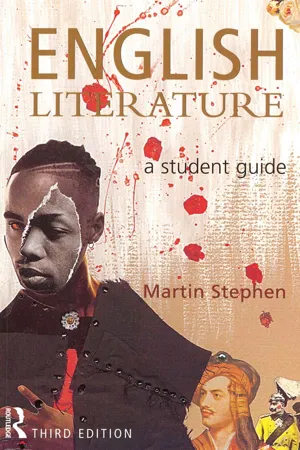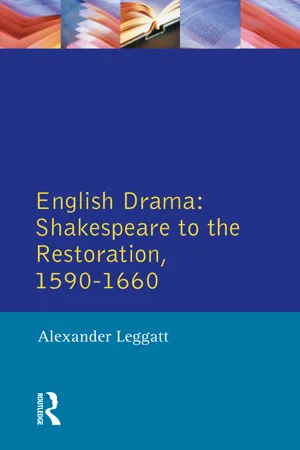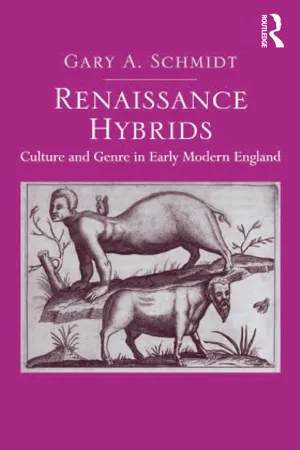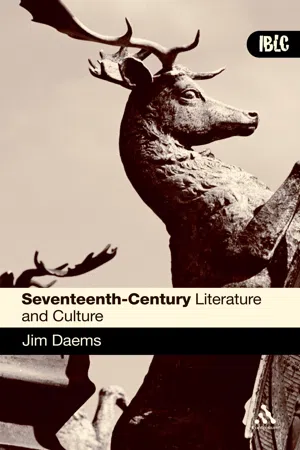Literature
Jacobean Drama
Jacobean Drama refers to the plays written and performed during the reign of King James I of England (1603-1625). It is characterized by its dark and violent themes, complex characters, and use of poetic language. Some of the most famous Jacobean playwrights include William Shakespeare, John Webster, and Thomas Middleton.
Written by Perlego with AI-assistance
Related key terms
Related key terms
1 of 4
Related key terms
1 of 3
5 Key excerpts on "Jacobean Drama"
- eBook - ePub
English Literature
A Student Guide
- Martin Stephen(Author)
- 2013(Publication Date)
- Routledge(Publisher)
CHAPTER EIGHTElizabethan and Jacobean Drama
The literary and historical background
No one has ever really explained why the thirty years from 1580 to 1610 saw one of the greatest flowerings that has ever taken place in English literary history, and probably in the history of world literature. Shakespeare, dealt with in the following chapter, was only part of this literary and dramatic boom, and perhaps not even the most highly thought-of by the age in which he lived. As with any intense flowering of literature, the reasons are historical, political, social, and economic, as well as literary. It is tempting to see a link between great outbursts of creativity in literature and social upheaval. English society in the Jacobean period had to come to terms with the Renaissance (the end of medieval thinking in Europe), the end of Queen Elizabeth I’s reign and the accession of a Scottish King (James VI of Scotland) to the throne of England, as James I, as well as the aftermath of its own battle with the Roman Catholic Church.As far as the Elizabethan and Jacobean period goes the flowering in the theatre was brought to an abrupt end by the English Civil War in 1642, when theatres were closed. They remained closed until 1660 and the restoration of the monarchy under Charles II. However, signs of decadence in the theatre had been visible much earlier than 1642, possibly even as early as 1615; certainly from the mid-1620s drama seemed to have little new to offer.The Theatre
The Elizabethan and Jacobean theatre was the first fully professional theatre in England, in the sense of professional actors performing in purpose-built theatres. There certainly had been acting before, with a religious and a secular input from the medieval mystery, morality, and miracle plays, and wandering troupes of performers putting on acts with no religious content. A favourite place for performing any travelling theatre or entertainment was the yard of an inn. These were often built on three sides of a square, the fourth being open for access by horses and wagons. The inn was a natural meeting point for the locality, could offer accommodation for the players, entertainment for guests, and presumably an increased profit for the innkeeper. By mounting a portable stage at the far end of the inn yard, more expensive seats could be sold for the galleries and rooms that overlooked the yard, whilst cheaper viewing positions could be offered on the floor of the yard itself, at ground level. - eBook - ePub
English Drama
Shakespeare to the Restoration 1590-1660
- Alexander Leggatt(Author)
- 2014(Publication Date)
- Routledge(Publisher)
Part Two: Early Jacobean DramaPassage contains an image
Chapter 6 The Early JacobeansThe terms ‘Elizabethan’ and ‘Jacobean’ are seductive, inviting a neat contrast between a golden age under a loved and splendid queen and a time of disillusionment and breakdown under an unpopular, neurotic king. But of course the culture of England did not change overnight in 1603. There was a strong vein of satire in the literature of the 1590s, and complaint and disillusion were already in the air. In drama, some of the qualities labelled ‘Jacobean’ were already in place. The sophisticated violence of Jacobean tragedy would not have been novel to audiences who remembered Titus Andronicus and The Spanish Tragedy. The tendency for tragedy and satire to converge in dark comedy leading to death was already present in The Jew of Malta (c. 1589).1 So, it can be argued, was the uncertainty about the universe in which man finds himself. In The Spanish Tragedy and Doctor Faustus we see gods, or God, at work and the spectacle is not reassuring. In Tamburlaine and Titus Andronicus it is hard to be sure what, if anything, is in the heavens.Nonetheless, there are developments that make Jacobean Drama distinctive. The most palpable difference is in verse style: a new freedom of movement, a more sustained conversational tone. We can hear the difference if we put a passage from The Spanish Tragedy (c. 1587) against one from The Revenger’s Tragedy (c - eBook - ePub
Renaissance Hybrids
Culture and Genre in Early Modern England
- Gary A. Schmidt(Author)
- 2016(Publication Date)
- Routledge(Publisher)
Chapter 5Jacobean Absolutism and the Rise of TragicomedyCrisis and Compromise
In 1616 the poet-sovereign King James I of England published his collected Workes ; in the same year, the esteemed jurist Sir Edward Coke was dismissed from the King’s Bench and the Privy Council for repeatedly invoking common law to hedge the King’s absolute power. In 1616, finally, the great Royalist poet and author of Jacobean masques, Ben Jonson, published his own Works ; the frontispiece of this audacious volume featured the figure of Tragicomoedia at the top of a Romanesque architectural façade, standing above (and therefore superior to) the lower figures of Satyr, Pastor, and the muses of Tragoedia and Comoedia.1 Linking these three contemporary events may at first seem a rather aimless exercise in ‘connect the dots’; however, as I shall argue here, the rise of tragicomedy in the early Stuart period owes its force and relevance to the political developments, philosophy, and contestations of the period. Tragicomedy emerged in the early years of James’s reign, in part, to mediate between the demands of the King’s absolutist philosophy and a society that had increasingly to account for the emerging interests of the landed gentry and radical groups such as the Puritans and Levellers.From the conservatism of the court masque to the festive misrule of city comedy, Jacobean literary genres consciously attempted to register and adapt to new social reorganizations and contemporary political developments. The pastoral tragicomedy inaugurated by Giambattista Guarini, in particular, emerged in its English incarnation as an ideal vehicle for such considerations. Franco Moretti maintains, for example, that ‘the ‘mixed’ form of tragicomedy embodies in its dramatic structure that compromise between the sphere of the state and civil society that was one of the great Elizabethan aspirations’ (61). Moretti emphasizes the essential conservatism of tragicomedy, seen in works that stage the monarch’s ability to effect an ‘organic restoration of hierarchy and meaning’ by satisfying nostalgia for a feudal worldview in which ‘man is what his sovereign makes him’ (67, 60).2 - eBook - ePub
- Michael Mangan(Author)
- 2014(Publication Date)
- Routledge(Publisher)
Part Two Shakespeare and the Theatre of His TimePassage contains an image
6 Elizabethan and Jacobean tragedyThe great age of English tragedy
Not every age has produced tragedies - or at least, not tragedies that are still read today. Broadly speaking, when we look back over the history of English literature, certain ages seem to have put their best energies into particular literary forms: for the Victorians it was the large-scale realist novel that demanded their greatest effort; for the early eighteenth century it was the urbane satire in verse or prose; for the Romantics it was the contemplative poem. This is not to imply that there were no novels written during the Romantic period, or that the Victorians did not write poetry: we are talking here only about some basic trends and the way in which particular art forms capture the imagination of a culture at particular times. The late sixteenth and early seventeenth century in England was a period when there was a variety of literary activity going on: lyrics, epics, satires, jestbooks, sermons, sonnets, essays all abounded. But it is usual to see this age as the great age of the English drama, and in particular as the great age of English tragedy. It is worth asking why this was so.A relationship may be posited, for example, between the writing of great tragedies in the early years of the seventeenth century and the social and economic conditions which were prevalent in England at the time. This relationship, it should be warned, is not a simple and direct one. Perhaps it would be reassuringly straightforward if it were: if, for example, one could say that the predominance of tragedies in this period were a direct result or expression of a social and economic crisis. Things are rarely that neat in literary history, however. The years we are talking about, from about 1590 through to about 1615 were not devoid of social, political and economic problems, as earlier sections have shown, but the crises of the period were no greater than those of the years immediately before and after this period. The constitutional and ideological upheavals of the mid-sixteenth century and the revolutionary years of the mid-seventeenth were more traumatic than anything that was happening between 1590 and 1615. If anything, it is more realistic to see this period as a comparative lull between the various storms which preceded and followed it. - eBook - ePub
- Jim Daems(Author)
- 2006(Publication Date)
- Continuum(Publisher)
Perkin Warbeck (published 1633). The decline of this genre has prompted a critical thesis that asserts that the Elizabethan and early Jacobean theatres were ‘national’ in taste. The history play especially contributed to a collective, national vision and consciousness among the social mixing of all classes in the public theatres. But, as a result of the success of the private, indoor theatres such as Blackfriars, a more exclusive upper-class audience became the prime target for playwrights, in part, no doubt, because of larger profits. There was, however, a negative effect, as the more exclusive Blackfriars audience preferred a refined form of comedy and tragi-comedy. Hence, the more homogenous class make-up of the audience beginning in Blackfriars imposed a particular path of development on the drama, the effects of which would be felt again at the Restoration.MasqueBesides the public theatres, playwrights had another forum -the court. In addition to performances of plays first produced on the public stage, a particular dramatic form developed at court. Evolving from a combination of courtly entertainments, including music, dancing and pageants, and taking its place within the ritual theatricality of court life, the masque was a spectacular multi-media event. Originally, the masque centred upon the entrance of masked dancers, but it became a more elaborate form during James I’s reign through the innovations of two men: Inigo Jones, who designed the sets and costumes, and Jonson. Jones is, incidentally, responsible for introducing the proscenium stage to England, and his ever more elaborate stage machinery and costumes contributed to the increasing expense of masques (and one must recall that, other than with rare exceptions, individual masques were only produced once). The masque proper was performed by aristocratic amateurs, occasionally even princes, princesses, and the king and queen. As a foil to the virtues represented by the aristocratic performers, Jonson first introduced the anti-masque in the Masque of Queens (1609). The anti-masque was performed by professional actors and added a symbolic, disruptive threat into the dramatic structure, though this was often treated comically. For example, in Jonson’s (Lindley 1998, p. 117) Pleasure Reconciled to Virtue (1618), the anti-masque consists of Comus, ‘the god of cheer or the belly,
Index pages curate the most relevant extracts from our library of academic textbooks. They’ve been created using an in-house natural language model (NLM), each adding context and meaning to key research topics.
Explore more topic indexes
Explore more topic indexes
1 of 6
Explore more topic indexes
1 of 4




